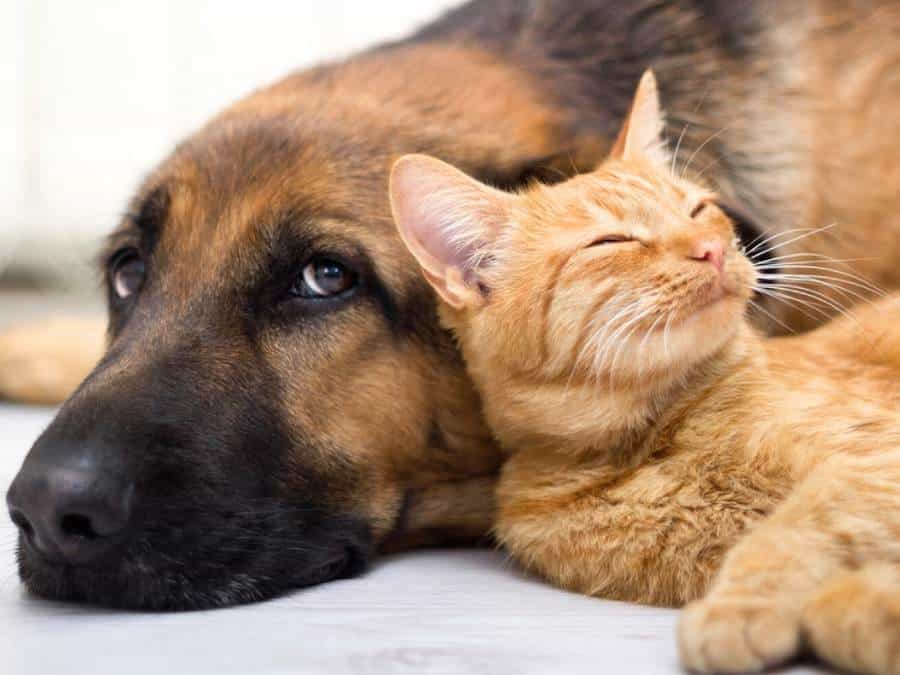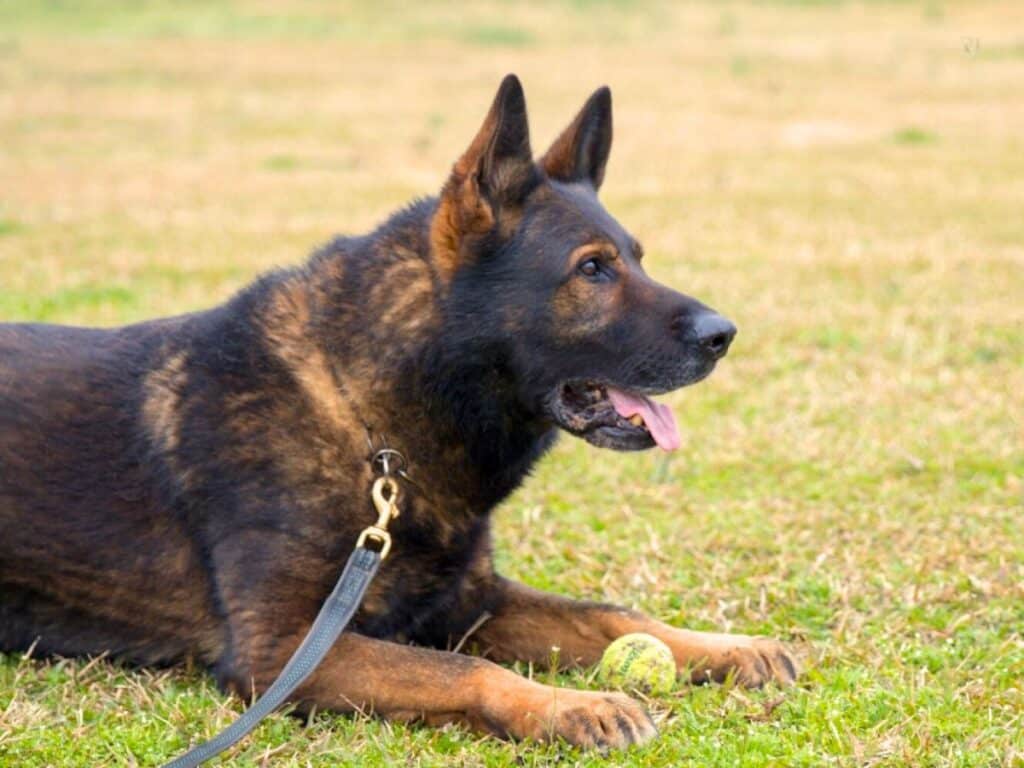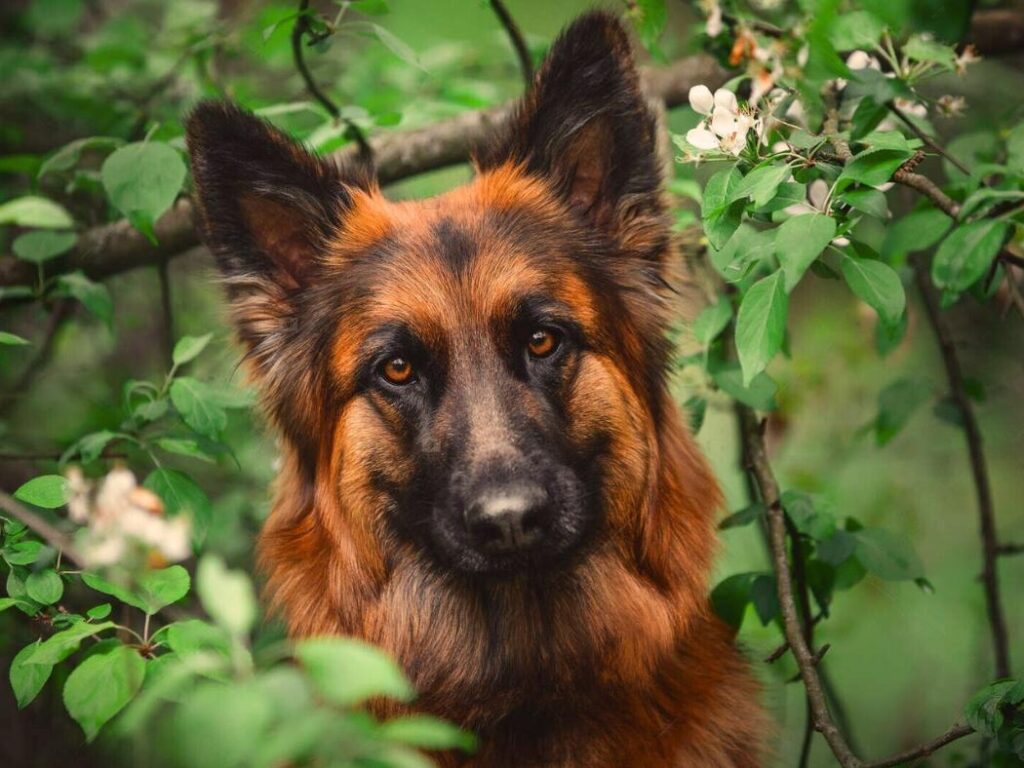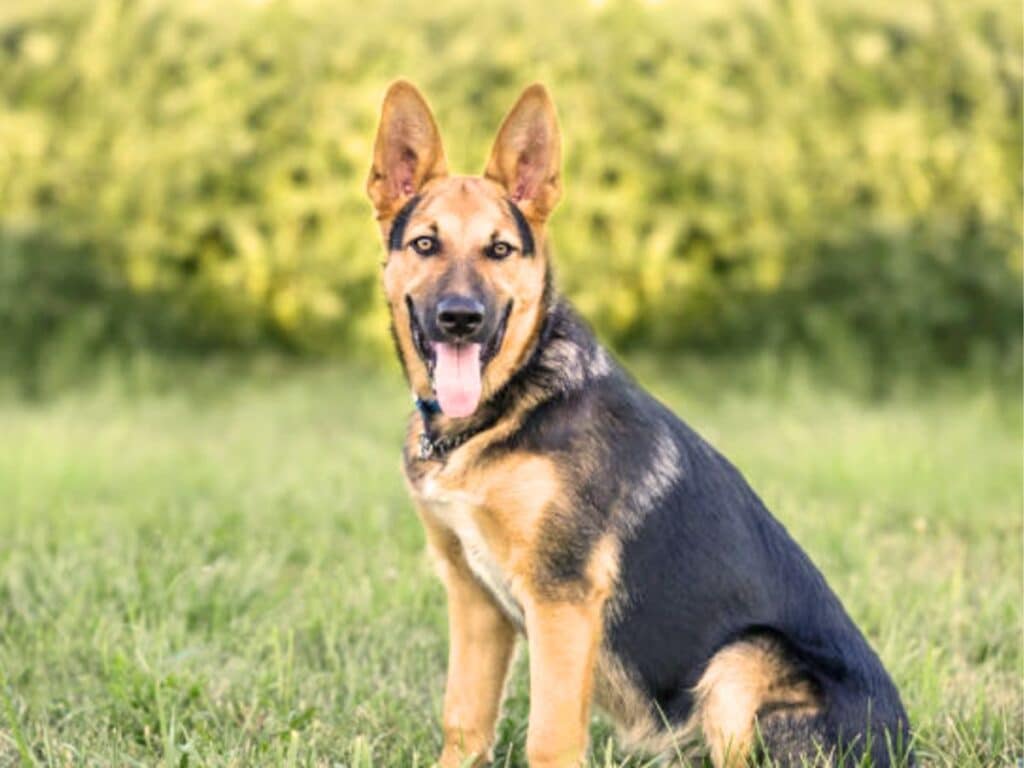German Shepherd’s strong prey drive and size often make potential owners wonder if they can coexist peacefully with cats under the same roof.
This blog post delves into the compatibility of German Shepherds with cats, exploring their temperaments, and the factors that influence their interactions with cats.
From understanding the nature of German Shepherds to practical tips for fostering a peaceful cohabitation, we’ll cover everything you need to know to create a harmonious multi-pet household.
Do German Shepherds Get Along With Cats?
German Shepherds can indeed get along with cats, especially when proper training, socialization, and introductions are conducted from an early age. Thanks to their intelligence, trainability, and inherently social nature, German Shepherds can learn to recognize cats as part of their family unit, fostering a peaceful coexistence.
The key to a successful relationship between a GSD and a cat lies in managing certain personality traits inherent to German Shepherds that significantly influence their interactions with cats and other animals.
Understanding these traits can help you facilitate better social dynamics within your multi-pet households.
Let’s find out what these traits are.
GSD Traits That Influence Their Interaction with Cats
1. High Prey Drive
German Shepherds have a strong instinct to chase and capture prey, a trait inherited from their herding and working origins. This drive is often displayed in their interest in moving objects, including running children, cyclists, and other small animals.
This high prey drive means that without proper training and socialization, a German Shepherd might chase smaller animals, including cats, squirrels, or even smaller dog breeds.
Training to manage this instinct and socialization from an early age can teach a German Shepherd to coexist peacefully with a cat.

2. Protective Nature
German Shepherds are naturally protective of their family and territory. This loyalty and protectiveness make them excellent guard dogs.
Their protective instinct can manifest as aggression or wariness towards unfamiliar animals, viewing them as potential threats.
However, when a German Shepherd is raised with other animals or properly introduced to them, they can become protective of these animals as well, treating them as part of their pack.
3. Intelligence and Trainability
Known for their intelligence, German Shepherds are among the easiest dog breeds to train. They excel in obedience, working roles, and problem-solving tasks.
This trait makes them highly adaptable to living with cats. Through training, they can learn to recognize other cats as part of their social group and not as prey or threats.
Their ability to learn commands such as “leave it” can be crucial in managing interactions with smaller pets.
4. Social Nature
Despite their formidable appearance and guard dog reputation, German Shepherds are social animals that thrive on interaction with their family, including other pets.
This social nature means they often seek companionship and can form strong bonds with other animals including cats.
Proper introduction and shared positive experiences can foster friendships between German Shepherds and other pets, leading to playful and protective relationships.
5. Territorial Behavior
German Shepherds have a strong sense of territory and may be inclined to guard their home and family against strangers, including unknown animals.
This trait requires careful management when introducing new pets into the household. Introductions should be done gradually and in a neutral space to minimize territorial responses.
Over time, as the German Shepherd becomes accustomed to the new animal, they can accept them as part of their “pack” and extend their protective instincts to include them.
RELATED: Are German Shepherds Good With Other Dogs?

Cat Traits That Influence Their Interactions With GSDs
Here are a few typical cat behaviors and traits that might play a role in how they interact with German Shepherds:
1. Independence
Cats generally exhibit a higher level of independence compared to dogs. They often prefer to have control over their interactions, choosing when to engage or retreat.
A dog’s enthusiasm or overbearing interest can be overwhelming for a cat, emphasizing the need for supervised interactions until both animals are comfortable with each other.
2. Communication Differences
Cats communicate differently from dogs, using subtle body language signals that dogs may not always understand. Misinterpretations can lead to misunderstandings between the two species.
For instance, a cat’s swishing tail can be a sign of irritation, whereas dogs may interpret it as an invitation to play, highlighting the importance of understanding these cues for peaceful cohabitation.
3. Escape Behavior
When faced with threats or uncomfortable situations, cats often prefer to flee and hide rather than confront. This flight response can be problematic if a dog perceives the cat’s movement as an invitation to chase.
RELATED: How To Stop a German Shepherd From Herding

How To Train a German Shepherd to Like Cats
Introducing a German Shepherd to a cat involves careful planning, patience, and gradual steps to ensure a positive and safe introduction. Here is a step-by-step guide to help you facilitate a smooth meeting between your German Shepherd and a cat:
Step 1: Prepare a Safe Environment
- Before the introduction, ensure that the cat has a safe space where it can retreat and feel secure. This area should be inaccessible to the German Shepherd and equipped with the cat’s essentials, such as food, water, litter box, and comfortable resting places.
- Use baby gates or barriers to create separate zones in your home, allowing both animals to get accustomed to each other’s presence and scent without direct contact.
Step 2: Scent Introduction
- Exchange scents between your German Shepherd and the cat by swapping bedding or toys. This helps both animals become familiar with each other’s scent, which is a crucial aspect of their communication and recognition.
- Feed them on opposite sides of a door or barrier to associate the other’s scent with positive experiences like eating.
Step 3: Controlled Visual Contact
- After a few days of scent swapping, allow the pets to see each other through a baby gate or a cracked door, ensuring that both animals remain calm. Keep these visual introductions short and positive.
- Continue with regular scent exchanges and gradually increase visual exposure time as both pets show signs of comfort and curiosity.
Step 4: Face-to-Face Introduction
- Choose a neutral, spacious area for the first face-to-face meeting, ensuring that the cat has the option to escape or hide if it feels threatened.
- Keep the German Shepherd on a leash and calm. It’s essential to maintain control over the situation to prevent any chasing or aggressive behavior.
- Allow the cat to approach the German Shepherd on its terms. Do not force interaction; instead, let curiosity guide their actions.
Step 5: Supervised Interaction
- Continue with supervised interactions, gradually increasing the time they spend together under your watchful eye. Always be ready to intervene if necessary.
- Observe their body language closely for signs of stress or aggression, and separate them if the interaction seems to escalate negatively.
Step 6: Gradual Unsupervised Interaction
- Only allow unsupervised interactions once you are confident in their ability to coexist peacefully. This may take several weeks or even months and requires observing consistent positive behavior during supervised sessions.
- Continue to provide safe spaces for the cat to retreat to, ensuring it always has an escape route and a place to hide if needed.
Step 7: Regular Monitoring and Adjustment
- Regularly assess the dynamic between your German Shepherd and the cat, being mindful of any changes in behavior or signs of stress.
- Be patient and ready to adjust your approach as needed. The pace of this process will depend on the individual animals and their comfort levels.
Remember, every pet is unique, and the introduction process can vary significantly in length and complexity. Patience, positive reinforcement, and attentiveness to the needs and signals of both your German Shepherd and cat are key to fostering a harmonious relationship between them.
RELATED:

Signs That Your German Shepherd Can Get Along With Cats
Observing your German Shepherd’s behavior around cats can provide insights into their potential for coexistence. Here are signs that indicate your German Shepherd might get along well with cats:
- Calm behavior around cats: Shows no signs of aggression, excessive excitement, or intense focus when near cats.
- Obeys commands in presence of cats: Responds to commands like “sit,” “stay,” or “leave it” even when a cat is nearby, indicating they can control their impulses.
- Shows curiosity without aggression: Expresses interest in cats through sniffing or gentle approaching, without chasing or barking.
- Lack of prey drive activation: Does not attempt to chase after the cat when it moves quickly or jumps, indicating a controlled prey drive.
- Positive body language: Displays relaxed body posture around cats, such as a wagging tail at a low or mid-height, relaxed ears, and no fixation.
- Allows cats to approach: Comfortably lets a cat come close without showing signs of discomfort or dominance.
- Gentle Play: Engages in gentle play with cats, recognizing their limits and adjusting their strength accordingly.
- Eats calmly around cats: Can eat or rest without being territorial, allowing a cat to be nearby without showing signs of food aggression.
These signs suggest that your German Shepherd has the temperament and discipline to potentially live harmoniously with a cat.
Check out this cute video of a German Shepherd playing with cats…
Why Some German Shepherds May Not Get Along With Cats?
While many German Shepherds can and do live harmoniously with cats, there are reasons why some may struggle to get along with feline companions.
Here are key factors that can influence whether a German Shepherd might have difficulty getting along with cats:
- Uncontrollable prey drive: For some German Shepherds, their prey drive is stronger and may be triggered by a cat’s movements, leading to chasing or aggressive behaviors.
- Lack of early socialization: Dogs that haven’t been properly socialized with cats or other animals during their critical socialization period (usually up to about 14 weeks of age) may be more prone to aggressive or fearful reactions.
- Negative past experiences: German Shepherds that have had negative encounters with cats in the past may develop a lasting fear or aggression towards them.
- Miscommunication: Dogs and cats communicate differently, both verbally and through body language. Misinterpretations of signals can lead to conflict. For example, a cat’s hissing or swatting might be seen as a challenge or play invitation by the dog.
- Unique personalities: Just like people, each German Shepherd has its own personality. Some may be more dominant, anxious, or high-energy, making peaceful cohabitation with cats more challenging.
- Age and health: Older dogs or those with health issues might be less tolerant of cats, especially if the presence of a cat disrupts their routine or causes stress.
- Space and resources: Competition for resources like food, toys, and attention can lead to tension. Similarly, a lack of space for each animal to have its own safe area can increase stress and aggression.

Frequently Asked Questions
1. Are German Shepherd puppies good with cats?
German Shepherd puppies have the potential to be good with cats, particularly because puppies are generally more adaptable and open to forming new relationships compared to adult dogs.
Introducing a German Shepherd puppy to a cat during the puppy’s critical socialization period (typically up to about 14 weeks old) can significantly increase the likelihood of a positive relationship developing between them.
Supervised interactions are essential during this formative phase to ensure that the puppy’s natural curiosity and playfulness do not overwhelm the cat, teaching the puppy to recognize and respect the cat’s signals and boundaries.
Training commands such as “sit,” “stay,” and “leave it” are invaluable in managing the puppy’s behavior and ensuring the safety and comfort of both pets.
2. Should you get a cat if you have a German Shepherd?
German Shepherds, known for their intelligence, loyalty, and protective nature, can coexist peacefully with cats, especially when properly socialized and trained.
The key to success lies in the dog’s temperament, previous experiences with small animals, and your commitment to supervise and manage their interactions.
Ensuring your German Shepherd is socialized and well-trained, particularly in obeying commands that manage their behavior around the cat, will be vital.
3. Why is my German Shepherd obsessed with my cat?
German Shepherds are known for their strong prey drive, an instinct that might cause them to fixate on smaller animals, including cats, which move quickly and can trigger this chase response.
Additionally, dogs are naturally curious creatures, and your German Shepherd’s fascination with your cat might simply stem from an interest in its different behaviors, smells, and movements.
If the dog lacks sufficient mental and physical stimulation, they might focus their energy and attention on the cat as a source of entertainment or engagement.
Closing Thoughts
In conclusion, the relationship between German Shepherds and cats can vary widely, but with the right training, socialization, and circumstances, these two can live harmoniously under one roof. It’s essential to remember that each German Shepherd and cat is an individual, and their personalities play a significant role in how well they will interact.
Introductions should be done slowly and under controlled conditions to ensure a smooth transition. With patience, understanding, and a bit of effort, your German Shepherd can learn to see your cat as a member of the family rather than prey.
FURTHER READING:




